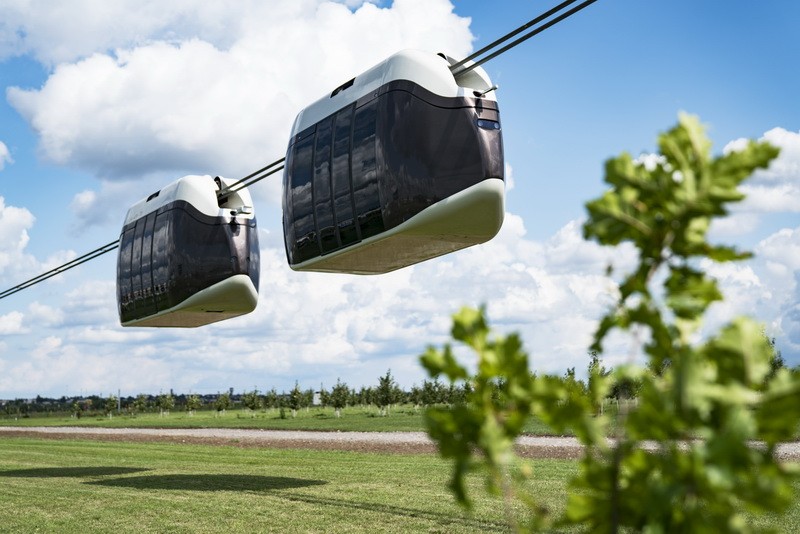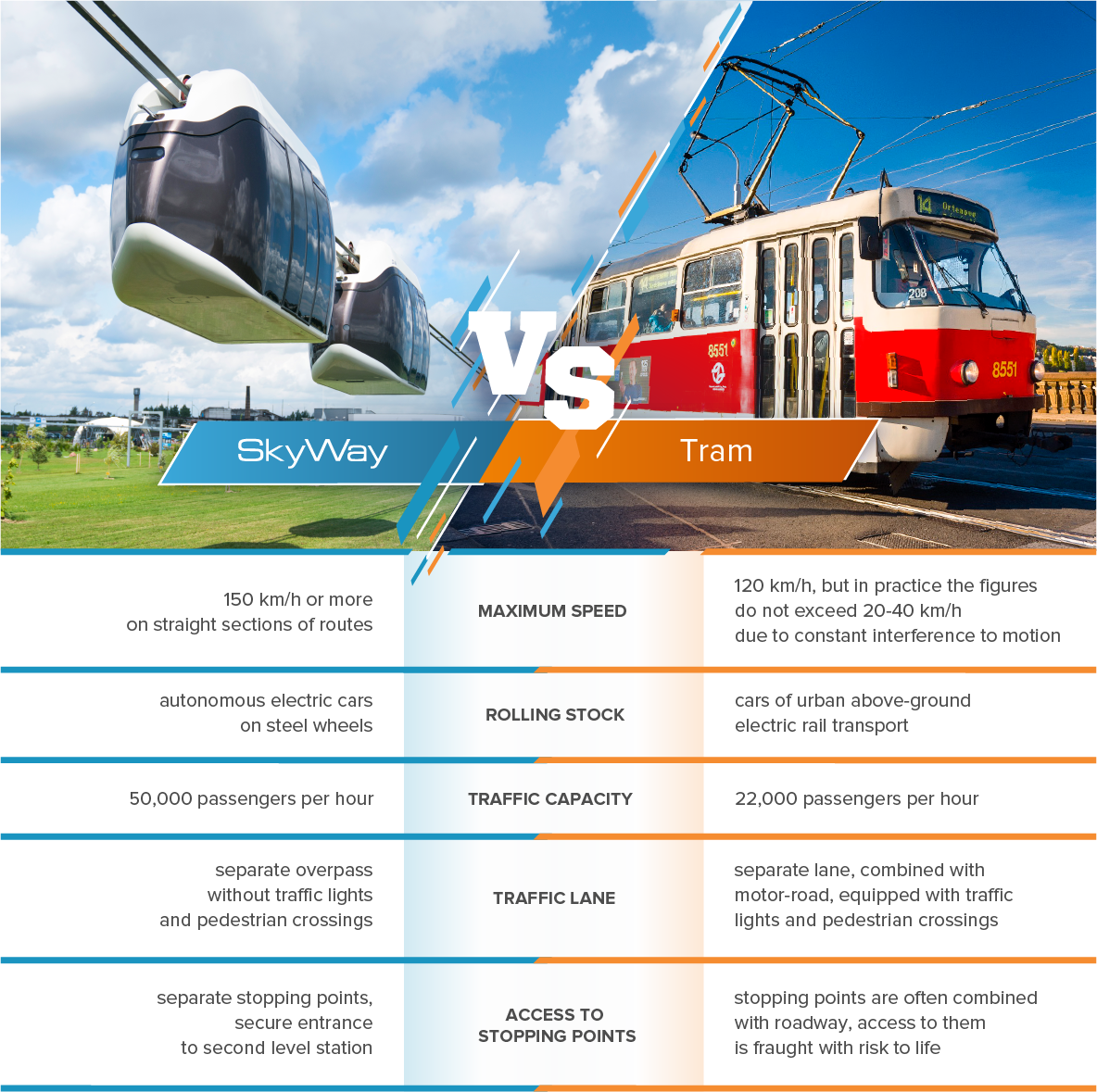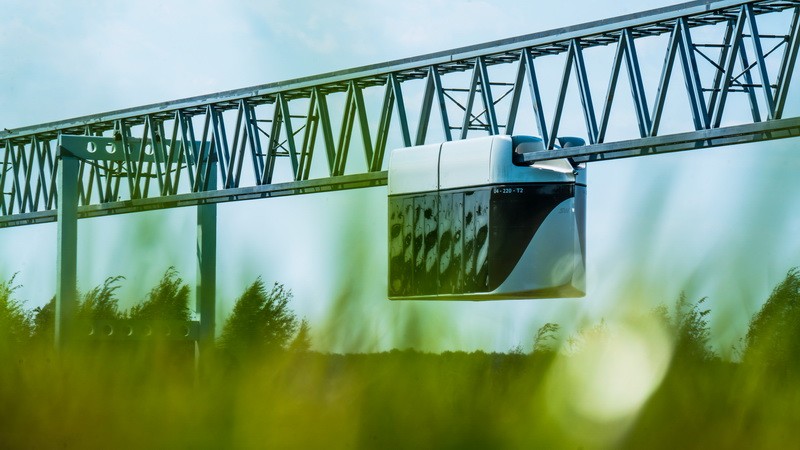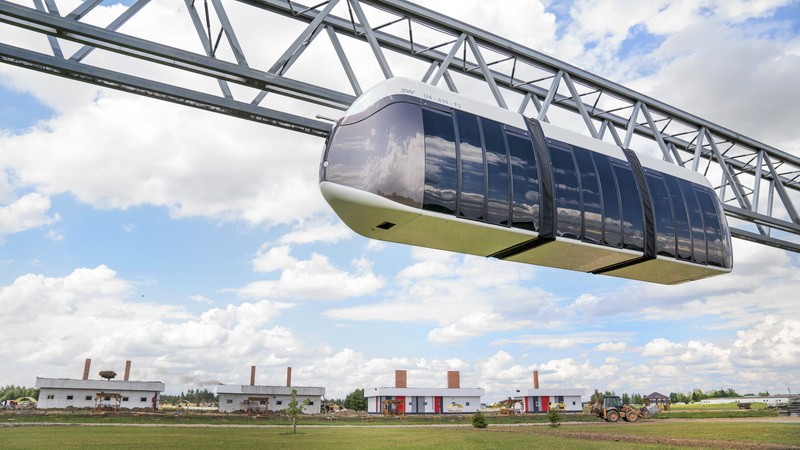

We continue the series of publications in which we will compare existing modes of transport with innovative SkyWay transport complexes. In the debut release we discussed the monorail, and today we will talk about the tram — one of the oldest modes of public transport.
As practice shows, it is quite difficult to find a worthy alternative to the tram. Judge for yourself: good passenger capacity, relatively low operating costs, environmental friendliness and a separate lane for motion. It would seem that this is an ideal solution for the arrangement of urban transport. But it’s not that simple. In addition to obvious advantages of using the tram, there are no less significant disadvantages. Let’s figure it out.

The history of the modern tram dates back to the 30s of the XIX century. Predecessors of trams began to appear in cities at that time — horse-drawn streetcars. The horse-drawn streetcar was a city railway, the cars of which were driven by draft animals, most often horses. Although, there were mules and even zebras. American cities such as Baltimore (1828), New York (1832), and New Orleans (1835) pioneered the introduction of horse-drawn streetcars.
However, horse-drawn railways became really popular thanks to the French inventor Alphonse Loubat, who proposed the idea of a railway rail with a groove for the wheel flange in 1852. Rails of this design could be sunk into the roadbed, which eliminated the main drawback of horse-drawn streetcars — rails projecting by 15 cm, which caused a lot of inconvenience to other traffic participants. In fact, the rails of Labois design are used to this day.

Unlike omnibus — a multi-seat horse-drawn wagon, traveling on usual roads— less rolling resistance of steel wheels on rails allowed a horse to move a heavier carriage. However, like its predecessor, the horse-drawn car had one serious drawback — the horse. The physical capabilities of animals affected the mode of operation on the passenger line (the working day of the horse is 5-6 hours). In addition, such “engine” required regular care and nutrition.
Taking into account that an average of about a dozen horses were used for one car, the cost of their maintenance was quite considerable. It was only a matter of time before the engine was installed on the tramcar.
In 1914, in New York, the horse-drawn railroad was closed, and it was replaced by the electric tram known to us. The same trend has been observed in other cities around the world. To date, the only operating horse-drawn railroad is the British Douglas horse-drawn tram located in the capital of the Isle of Man.
One of the key advantages of the tram is a separated lane for motion. This allows it to move in urban traffic at a higher average speed than, for example, a bus or a trolley-bus, carrying many more passengers.

However, realization of the full potential of a separate line is possible only if it is completely isolated from other road users — transport and pedestrians. In practice, this is quite difficult to achieve, especially if the tram lines run through residential quarters. Therefore, the tram can get into a traffic jam, and a road accident with its participation can completely paralyze traffic on a separate area.

In string transport complexes, the rolling stock moves along the track structure, which is located above the earth’s surface — at the “second” level.In string transport complexes, the rolling stock moves along the track structure, which is located above the earth’s surface — at the “second” level.In string transport complexes, the rolling stock moves along the track structure, which is located above the earth’s surface — at the “second” level.

This solution allows to get rid of the whole range of problems that are fraught with the neighborhood of other road users. It’s simple: no accidents, no traffic jams, and the high-speed mode of the rolling stock is not limited by anything. Well, and a great view from the window as a bonus.
By the way, city residents are very loyal to the tram. Why? The question is rhetorical. Most likely, because of the opportunity to ride in a mini-train in the city without going underground. But in this, purely aesthetic issue, string transport is a winner, offering the urban resident a unique opportunity to try out an electric car that moves on air rails.
The tram is operated by a driver — a tram-driver. With all the potential problems that come with it. The main one is safety. Any system will remain vulnerable due to the human factor, because no one is immune to errors. A pedestrian accidentally ran onto the tram tracks? An inattentive driver did not give way and the tram did not manage to brake in time? As a result, we get downtime on the line, financial losses for the carrier and the affected parties. And it is good if the affected persons get off with purely material losses.
Attempts to automate the city tram are being made: in September 2018, as part of the International exhibition InnoTrans in Berlin, Siemens demonstrated the Combino tram, which carried passengers on a 6-kilometer section in Potsdam. The tram had the equipment that is used in unmanned vehicles: cameras, lidar and radar operating in conjunction with software. The successful introduction of autonomous trams can significantly improve the safety of this transport. However, as long as it moves on the same level with other traffic participants, the threat will remain quite significant.


In SkyWay transport and infrastructure complexes, rolling stock is already fully automated presently. Due to the location of the track structure on the "second level", the absolute majority of possible obstacles to rolling stock disappears. Consequently, the number of variables that the control system must handle is reduced. This means that such a system can be made more reliable and efficient than the existing analogues.
“Smart” SkyWay vehicles are not only capable to distinguish obstacles in their path, constantly monitor the safe interval between individual transport modules, but also carry out automatic docking with a faulty module and its further towing to the depot.

SkyWay rolling stock control system is able to recognize faces already now, which allows it to track cases of deterioration of a passenger’s health, as well as timely identify and prevent illegal actions, such as, for example, acts of vandalism. In addition, it is constantly self-learning, which means that the level of safety in string transport systems will constantly grow.
Among all types of urban public transport, the tram is among the leaders in terms of carrying capacity (high-speed versions — 22,000 passengers per hour) and rolling stock capacity, second only to the metro. The number of cars on the tram line is easily increased due to coupling, without increasing the number of drivers.
The speed of modern trams can reach 120 km/h, but in practice the operating performance varies from 20 to 40 km/h due to the location on the “first level” and constant interference from traffic. That is again due to the fact that trams run on public roads. By the way, tram systems with an average operating speed above 24 km/h are called high-speed in the CIS.
In urban SkyWay transport complexes capacity can be 50,000 passengers per hour and more, and the maximum speed of the rolling stock can reach 150 km/h and more. It is clear that this should be on straight sections of the tracks and for heavy versions of the city complex, in which trains with a capacity of 200 – 300 passengers move. It is also obvious that if there are curves on the track, say, with a radius of 200 meters, the speed in them cannot be higher than 36 km/h due to lateral centrifugal accelerations, which cannot be higher than 0.5 m/sec2 for physical reasons. And this is not a disadvantage of SkyWay, it is the laws of physics which is obeyed by all transport systems, including string transport.
Respectively, speed of 150 km/h cannot be reached, if there are, for example, 500 m between neighboring stations. Maximum – about seventy kilometers per hour in the middle of the span, again based on the laws of physics, since the comfortable rate of acceleration and braking should be less than 1 m/sec2.
Therefore, the capacity of 50 thousand passengers per hour and the speed of 150 kilometers per hour are the possibilities of urban string transport, and the specific characteristics of a particular urban transport line are determined by a feasibility study or a business plan for a particular targeted project.

The tram has an impressive margin of efficiency, but the cost of its “entry” into a city remains quite high. This is a fact. The cost of building 1 km of the city tramway line will cost, on average, about 10 million USD. However, these figures are very conditional, since they do not take into account the cost of rolling stock, infrastructure, power supply and much more, because they can vary depending on the specific location for construction. For example, the preliminary estimate of the project on the Moscow-area (not Moscow) tram line from Podolsk to Ramenskoye (via Domodedovo and Zhukovsky airports) amounted from 92 to 98 billion Russian rubles for a 74 km long section with 16 stations. And this is more than 20 million USD per kilometer, including infrastructure. However, as a rule, the most expensive part of any tram project (the cost of urban land) is not taken into account.
But the high cost of construction of tram lines is justified by other advantages of this mode of transport — durability, environmental friendliness and low travel fare.
Unlike road transport, the tram does not pollute the urban environment with the products of combustion of hydrocarbons, the products of wear of pneumatic tires and asphalt, and its tracks can be combined with a green lawn, which also has a beneficial effect for the urban microclimate.

The service life of a bus or trolleybus is 10-20 years, and for a tram car 50 years is not a problem. In addition, in recent years, trams have been equipped with systems converting direct current suppled to the tram into alternating current. This made it possible to install on the tram AC electric motors, which practically do not require maintenance, since they do not have fast-wearing and rubbing parts.
The tram can also boast of a fairly low cost of travel — by 40% lower than in a bus or trolleybus.
The obvious drawback of the tram — noise and vibration — should also be mentioned. The maximum technical weight of a tram car (with passengers) can reach 50 tons, which, coupled with heavy metal wheelsets, uneven rails and joints between them, is guaranteed to ensure shaking of dishes in the kitchen cabinet of a city dweller. In addition, facades and foundations of buildings suffer from it. Of course, this can be partially corrected by installing a vibration-insulating roadbed, rubberized wheels and thermite welding of rails into a string, but it will not work to get rid of the “branded” tram rumble completely.

SkyWay transport systems are characterized by low material consumption. Due to the string rails, the track structure can withstand heavy loads, while remaining lightweight and durable. Low material consumption means low cost of construction.
SkyWay rolling stock is fully electrified, which means its impact on the environment is practically reduced to zero. The safety margin of the track structure is designed for operation during 100 years, rolling stock — 25 years.
Steel motor-wheels of a special design are used as a drive in SkyWay rolling stock. They are characterized by low rolling resistance due to the narrow (in the rolling direction) contact spots. Motor-wheels in tandem with outstanding aerodynamic performance ensures low power consumption of the rolling stock.
A continuous overpass, filling string rails with special concrete and the use of composite materials in the design of the motor-wheel successfully solve the problem of noise emission in string transport complexes. In the future, SkyWay rolling stock should become almost silent, since work in this direction does not stop.

Low power consumption and low capital costs for the construction of SkyWay transport complexes provide together a low cost of travel for the passenger. According to calculations, the cost of a ticket on SkyWay city lines will be lower than that of possible competitors.
The advantages of the tram are leveled in the end by one, but crucial drawback — the need to “share” the street space with other traffic participants. Of course, the most problematic areas can be taken to a separate level — an elevated overpass or an isolated underground line. But in this case, the cost of construction will inevitably increase manifold, which will question the feasibility of their construction.
String transport complexes are devoid of the shortcomings inherent in trams, even at the designing level. High speeds, efficiency, unprecedented level of safety and comfort for passengers, low cost of construction, cost effectiveness... the advantages of SkyWay can be talked about for a long time, but even these mentioned above are quite sufficient to make a simple conclusion: a worthy alternative to existing modes of transport has already been created.
You can assess the importance of a particular publication and the level of its preparation. Share your opinion in the comments!
This form asks for your consent to allow us to use your personal data for the reasons stated below. You should only sign it if you want to give us your consent.
Who are we?
The name of the organisation asking you for consent to use your information is:
Global Transport Investments
Trident Chambers, P.O. Box 146, Road Town
Tortola
British Virgin Islands
We would like to use the following information about you:
Why would we like to use your information?
Global Transport Investments would like to send this information to company registry, inform you about its news, for refund purposes.
What will we do with your information?
We store your name, address, ID Data, date of birth into company registry. We will share your e-mail & phone number with IT Service (https://digitalcontact.com/), SMS Center (http://smsc.ru). They will add your details to their mailing list and, when it is news update, they will send you an email or sms with details. We store your credit card number for possible refunds.
How to withdraw your consent
You can withdraw the consent you are giving on this form at any time. You can do this by writing to us at the above address, emailing us at the address: [email protected] or by clicking on the unsubscribe link at the bottom of emails you receive.
This privacy notice tells you about the information we collect from you when you sign up to receive our regular newsletter via our website. In collecting this information, we are acting as a data controller and, by law, we are required to provide you with information about us, about why and how we use your data, and about the rights you have over your data.
Who are we?
We are Global Transport Investments. Our address is Trident Chambers, P.O. Box 146, Road Town, Tortola, British Virgin Islands. You can contact us by post at the above address, by email at [email protected].
We are not required to have a data protection officer, so any enquiries about our use of your personal data should be addressed to the contact details above.
What personal data do we collect?
When you subscribe to our newsletter, we ask you for your name and your email address.
Why do we collect this information?
We will use your information to send you our newsletter, which contains information about our products.
We ask for your consent to do this, and we will only send you our newsletter for as long as you continue to consent.
What will we do with your information?
Your information is stored in our database and is shared with with IT Service (https://digitalcontact.com/), SMS Center (http://smsc.ru). It is not sent outside of the Euro. We will not use the information to make any automated decisions that might affect you.
How long do we keep your information for?
Your information is kept for as long as you continue to consent to receive our newsletter.
Your rights over your information
By law, you can ask us what information we hold about you, and you can ask us to correct it if it is inaccurate.
You can also ask for it to be erased and you can ask for us to give you a copy of the information.
You can also ask us to stop using your information – the simplest way to do this is to withdraw your consent, which you can do at any time, either by clicking the unsubscribe link at the end of any newsletter, or by emailing, writing us using the contact details above.
Your right to complain
If you have a complaint about our use of your information, you can contact the Information Commissioner’s Office.
Замечательная статья.